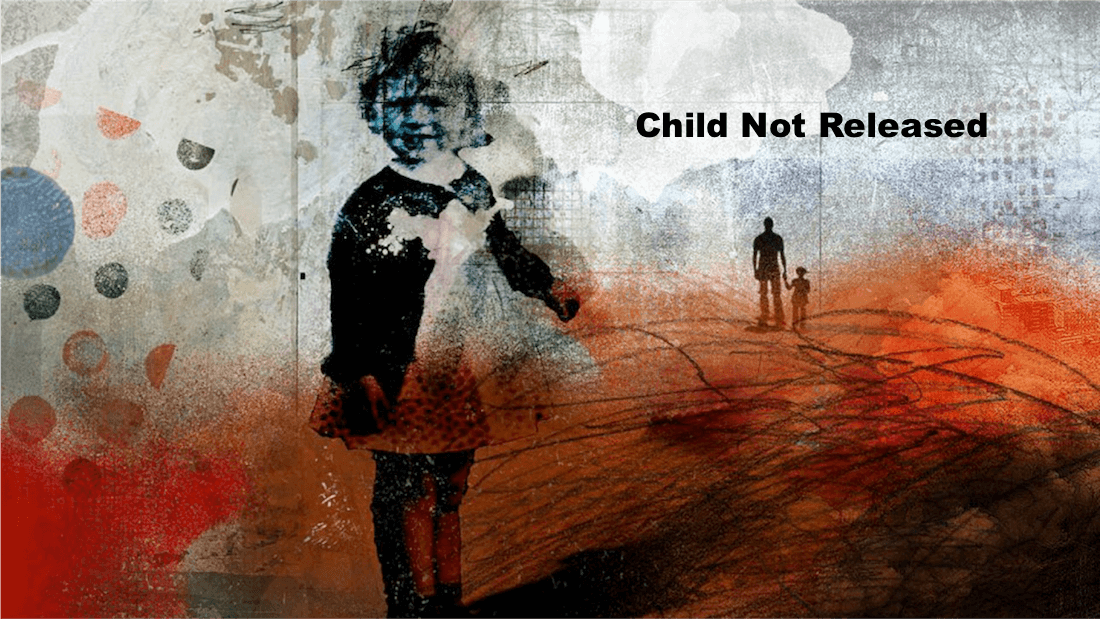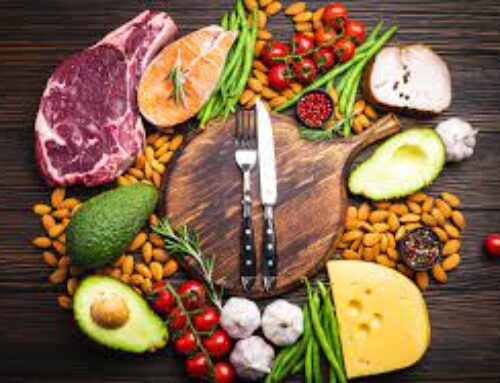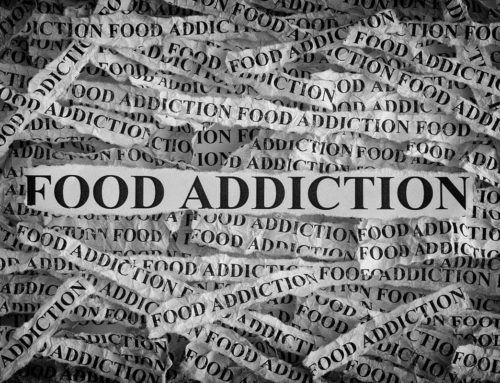I went to the Chiropractor this week and got X-rays done of my back and found that it is as crooked as a question mark. The problem originated from my feet losing their arches over my years of killing them in the restaurant industry with twelve-hour shifts, unsupportive shoes, and a weight problem that likely tipped the boat. My arches have diminished at different rates, however, which has caused a leveling problem. I am unbalanced, and my back knows it. It is trying to correct the problem on its own by curving to accommodate my unsymmetrical feet. The curve has become its own problem now.
This is the mechanism that is happening in addiction.
I’m Katie. And I am a food addict.
I recently met someone in the weightlifting industry who asked about my work in helping people with overeating issues. He asked followed by a chuckle, “So, what is a food addiction exactly? What do you just like eat all day and night?”


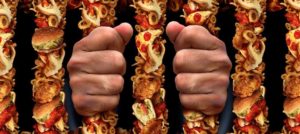

At first I wanted to smack him in the mouth a little bit for his ignorance, especially because he is in the industry of helping people be fit. But then I remembered that we live in a society that does not acknowledge food addiction as a thing because it is easier to sit in judgment and call someone fat and lazy and never try to make any real connection to their problems. How could I blame him for not knowing?
Evidence that society does not know or acknowledge food addiction as a real phenomenon lies in the fact that half of the time when I tell people about food addiction, they add with a chuckle, “Yeah, I’m addicted to chocolate” or “Yeah, I’m a carb addict.” There is a joking energy in the conversation almost every time; all the while I am holding in the back of my head the memory of becoming suicidal over this problem.
We can begin to heal our relationships with food when we stop treating eating issues as jokes, everyday problems, issues of laziness, or embarrassing topics.
An addiction is characterized by anything we attach ourselves to, regardless of the negative consequences we know are derived from that attachment. A smoker knows cigarettes are bad and can kill, but he still smokes. A heroine addict knows that his next hit can kill him; yet he would give everything he has for it. Someone struggling with a gambling addiction knows that putting up their last bit of money could lose the house and the family, but he still goes to the ATM for more cash.
A food addict who is severely overweight and unhappy knows that another binge day could add another five pounds, but she has the binge anyway. She knows that going and getting a six-pack of cupcakes will make her feel terrible afterwards, but she decides to go and get them and adds ice cream to it. This woman (we’ll say woman because I am reflecting here) sacrifices her health and her long-term happiness just to get through a moment. She is a practical person usually, but not in this moment. She knows the feeling of goodness only lasts for a moment, and she still seeks a binge.

Do people honestly think that someone in their RIGHT mind, whatever that is, would CHOOSE to give up life over the momentary taste or enjoyment of something? I think not. Many people with addictions are extremely intelligent human beings. Let’s go a little deeper, shall you?
Why do I do what I do? Why do I incessantly think about my next food item all day long? Why is the idea of not eating sugar for a week out of this world for me? If sugar and processed foods are so addictive, then why are you not all doing the same thing that I am doing? Don’t you, too, want to have a dozen donuts all to yourself?
Let’s look at the behaviors before we get to those answers.
The very nature of food addiction is to stuff or to gorge; it is an overfilling of sorts. Food addicts, like myself, likely do not even taste the food after a certain number of binge-bites. The mindless act of stuffing food is exactly that – without the mind. The addict successfully cuts off thoughts from the mind in order to perform the act of binging. This is the only way the binge-eating is successful and fulfilling.

What is this person seeking who binge eats in this way? Comfort, dopamine, joy, a break from their thoughts, the need to need something after one has decided he or she needs no one, and control are perhaps some of what sits at the finish line of binging. Based on the chiropractic analogy, this means that the person is self-correcting for lack of these things in life. The binge is the back curving for a lack of symmetry. The addict is seeking leveling.
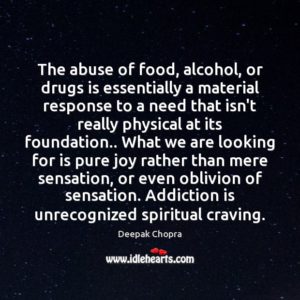
Furthermore, to go deeper into the science of addiction, studies have shown that when babies try to get responses from their parents and have an absent-minded parent who frequently does not respond, these babies lose out on the natural endorphins produced in the body normally when parents do respond. Over time in an environment where there is little response to the emotions of a child, the child finds other means of endorphins. This is another example of self-leveling. It has also been studied that these children have fewer dopamine receptors over time, and the prefrontal cortexes of their brains do not develop properly, impairing their ability to make sound decisions. These babies grow up with higher potential for addictive behaviors.

The messages often derived from this absent-mindedness include “I do not need anyone” and “I can comfort myself.” Growing up in this type of trauma is one of the many examples of a life leading to addictive behaviors by people who are seeking the things they lack – control, feel-good hormones, comfort, and needs! This is an extremely simplified version of these types of studies, but there is a world of psychology here to explore.

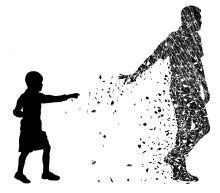

The behaviors result as a means for correcting a lacking. It is the curving of the back to level out the feet. It is a gorging for an emptiness, a covering for an unwanted exposure, a clinging for the “I need no one”, a comfort for the life that keeps me afraid, and a distraction from all of that. These “self-correcting” behaviors begin forming in the earliest stages of brain development for many people who are born to an absent or emotionally absent parent. These are the first years we learn about attachments, and our caregivers are supposed to be the first healthy attachments we have. When they are not, our brains close off and stop developing with the same capacity for good decision-making, healthy attachments, and a normal amount of dopamine levels. Again, this is a very simplified version of what happens to traumatized children, and there is a world of science that proves this.
As Dr. Gabor Mate describes in his book “In the Realm of Hungry Ghosts,” if you put a baby in a dark room isolated from his or her caretakers, giving it all the nutrients it needs to physically survive, the baby will still lack development cognitively, and his or her brain becomes wired to seek out other forms of dopamine and endorphins. This is our survivalist nature.
Therefore, the addict seeks to survive what the brain deems as threats to balance.
This is some science behind addiction, mostly found in my studies in the work of Dr. Gabor Mate. He also teaches me that these developments can be unlearned in some ways with work on the brain, consistent care for self through abstinence whenever I can get through the moment, and a total loving humanitarian approach with myself on the issue of food addiction, unlike any approach I have ever received from others, even those with the best intentions.

I have a food addiction, whether wired a long time ago in my brain or not, that wakes me up and tucks me in daily. It cannot be shamed with a “Come on, Katie, really?” or fixed with a diet plan or any amount of inspiration. It is impractical and protective and only moves with my own budging. According to Dr. Mate, the very part of my brain that is damaged is also the part of my brain that is responsible for making good choices in addictive manic moments.
I immerse myself with healing by going to a gym and a community that encourages me, by joining health groups with shared goals, and by participating in healthy movement in my life now. I left my years of restaurants to find the best version of me in the counseling world. I want to help people who are living with my same struggle to find immersion in healing themselves. I know I will learn more as I teach and seek to fulfill my purpose of understanding and working with addicts of all struggles.
There is so much here to explore, not to add to a pile of “excuses” about addiction, as someone without one might deduce, but to bring knowledge and understanding where there is often a dark blurry cloud blocking the answers for many people. The more we see, the less we are afraid to see. I am not afraid anymore of seeing anything. When our eyes are open, we can walk forward.
Stay tuned for next week’s “The Life and Thoughts of a Food Addict: Part Three.” Feel free to explore with me and reach out either at innerfitnessnc.com on the Contact page, or email me at [email protected].

